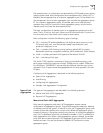
Configuring Link Aggregation 43
The operation key is a configuration set generated by LACP based on port setting
(speed, duplex mode, basic configuration and management key). When LACP is
enabled, the management key of a dynamic aggregation port is 0 by default, but
the management key of a static aggregation port includes the aggregation group
ID. For a dynamic aggregation group, all member ports must have the same
operation key, while for a manual or static aggregation group, only the active
member ports must have the same operation key.
The basic configuration of member ports in an aggregation group must be the
same. That is, if one is a trunk port, others must be trunk ports also. If a port turns
into an access port, then others must change to access ports.
Basic configuration includes the following types of settings:
■ STP — Includes STP enabling/disabling, link attribute (point-to-point or not),
STP priority, path cost, max transmission speed, loop protection, root
protection, edge port or not
■ QoS — Includes traffic limiting, priority marking, default 802.1p priority,
bandwidth assurance, congestion avoidance, traffic redirection, traffic statistics
■ VLAN — Includes permitted VLAN types and the default VLAN ID
■ Port — Includes port link type
The Switch 7750 supports a maximum of sixty four load-balance groups, with
each group containing a maximum of eight 1000M ports or sixteen 100M ports.
For the 48-port 10/100BASE-T auto-sensing fast Ethernet interface card, a port
grouped in first 24 ports cannot be aggregated with the one grouped in the last
24 ports.
Configuring Link Aggregation is described in the following sections:
■ Types of Link Aggregation
■ Load Sharing
■ Configuring Link Aggregation
■ Example: Link Aggregation Configuration
Types of Link
Aggregation
The types of link aggregation are described in the following sections:
■ Manual and Static LACP Aggregation
■ Dynamic LACP aggregation
Manual and Static LACP Aggregation
Both manual aggregation and static LACP aggregation require manual
configuration of aggregation groups. They prohibit automatic adding or deleting
of member ports by the system. A manual or static LACP aggregation group must
contain at least one member port, and you must delete the aggregation group,
instead of the port, if the group contains only one port. At a manual aggregation
port, LACP is disabled and you are not allowed to enable it. LACP is enabled at a
static aggregation port. When a static aggregation group is deleted, its member
ports form one or several dynamic LACP aggregation groups and LACP remains
enabled on them. You are not allowed to disable LACP protocol at a static
aggregation group.


















